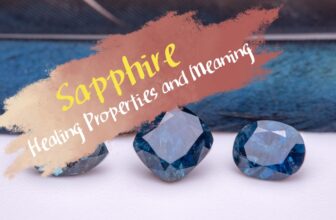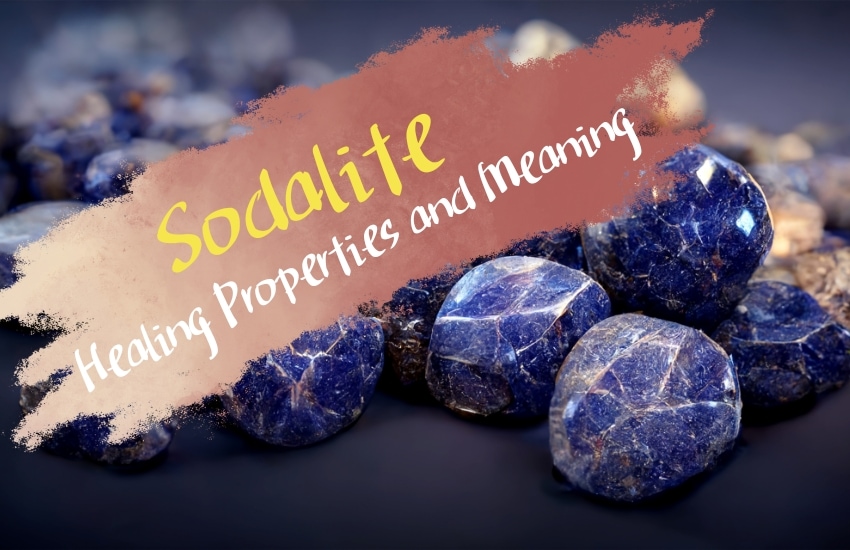
Table of Contents
Don’t let the bland name fool you, sodalite is a wonderful stone with many healing, metaphysical, and practical benefits. These capabilities derive from the range of blues and purplish hues in this stone, which come from its mineral content.
Owing its name to the massive levels of sodium contained within, sodalite is a crystal of communication, poetry, creativity, and heroism. It’s therefore representative of courage, wisdom, right action, and proper thought processes.
In this article, we’ll explore the meaning and healing properties of sodalite, and how it can benefit your mind, body, and spirit. Whether you’re a gemstone collector or simply looking for ways to improve your well-being, sodalite is a powerful tool that can help you achieve your goals.
What is Sodalite?
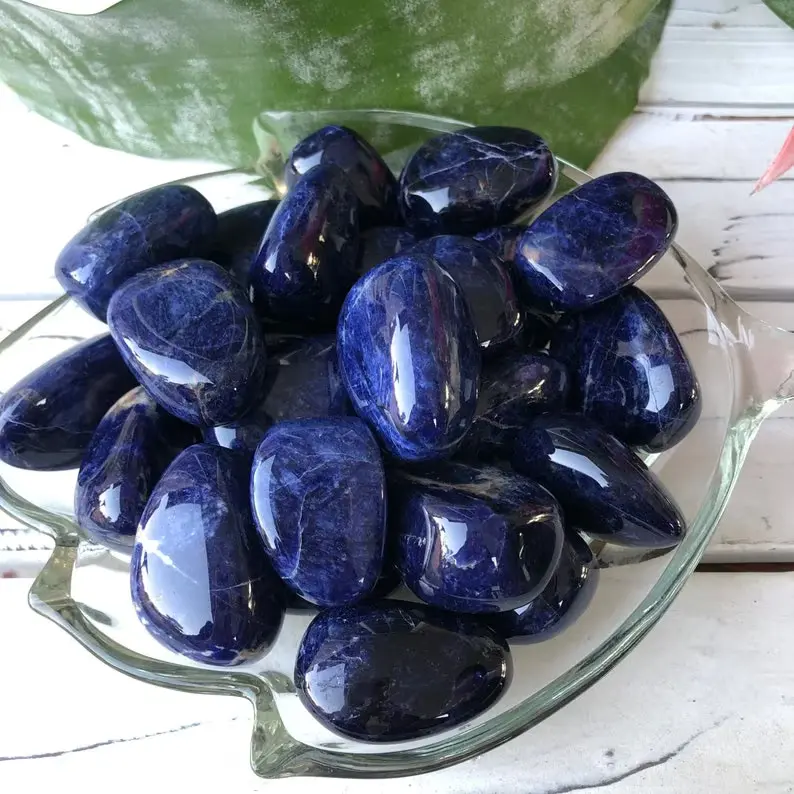
Immediately identifiable by its light blue to intense indigo color, sodalite is a rare rock-forming tectosilicate mineral that’s part of the feldspathoid mineral family. It has a chemical composition of Na4Al3Si3O12Cl, meaning it contains sodium, aluminum, silicon, oxygen, and chlorine. It has a cubic crystal system and groups with other stones like lazurite and hauyne (or hauynite).
Sodalite has a hardness of 5.5 to 6 on the Mohs scale, which means it’s considered a relatively soft mineral. The Mohs scale is a measure of a mineral’s hardness, with 10 being the hardest (diamond) and 1 being the softest (talc). Sodalite’s hardness is similar to other popular gemstones like turquoise, lapis lazuli, and opal.
While sodalite is not as hard as some other gemstones like sapphires or diamonds, it’s still durable enough to be used in jewelry and decorative items with proper care.
The Color of Sodalite
Sodalite is typically characterized by its deep blue color, although it can also contain white veins or patches, as well as gray, green, or yellowish-brown hues. The blue color of sodalite is caused by the presence of the mineral component, lazurite. The intensity and shade of blue can vary depending on the amount of lazurite present, with more intense blue hues being highly prized in gemstone circles.
Interestingly, sodalite’s blue color can also be enhanced or changed through various treatments such as heating or irradiation. In some cases, sodalite may also exhibit a phenomenon known as chatoyancy, which produces a silky, reflective effect when viewed from certain angles. This effect is caused by the presence of fibrous inclusions within the stone.
Where is Sodalite Found?
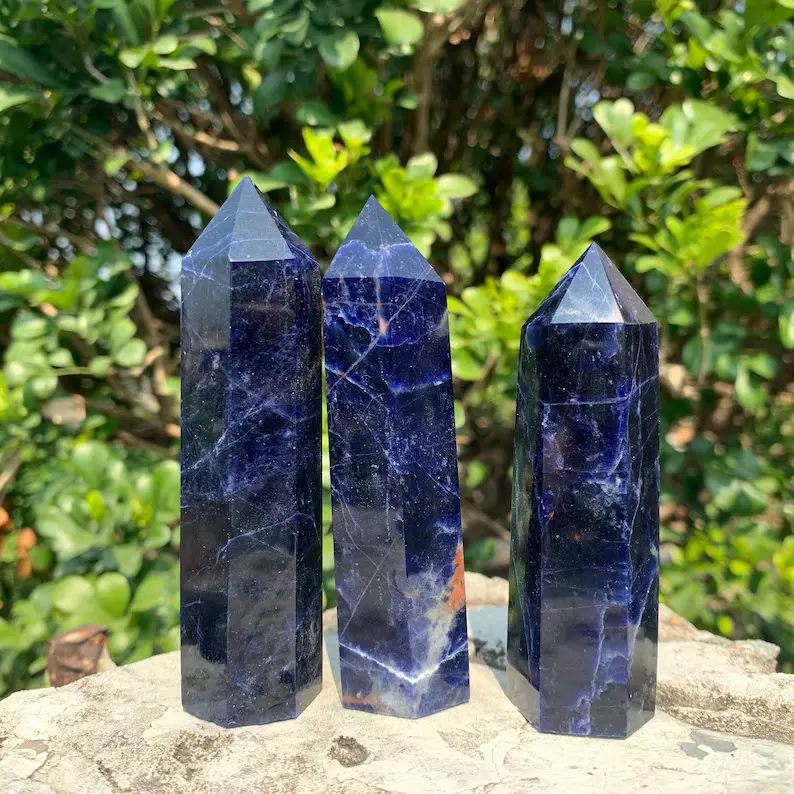
Sodalite is primarily formed through a process known as metasomatism, which involves the alteration of existing rocks through the addition or removal of elements. It typically forms in silica-poor rocks such as syenites, phonolites, and nepheline syenites, which are alkaline igneous rocks. The mineral forms in cavities and fractures within these rocks, where it crystallizes from mineral-rich fluids that have undergone significant chemical changes.
The formation of sodalite involves the interaction of several elements, including sodium, chlorine, aluminum, silicon, and sulfur. These elements combine to form a complex network of interconnected atoms that give sodalite its distinctive crystal structure and physical properties.
Over time, as the fluids that contain these elements move through the rock, they interact with other minerals and compounds, causing chemical reactions that can alter the composition and texture of the rock. These changes can result in the formation of new minerals like sodalite, as well as other materials like zeolites and carbonates, which are often found alongside sodalite deposits.
The formation of sodalite is a complex process that requires specific geological conditions and a delicate balance of chemical elements. The resulting mineral is a beautiful and unique gemstone that has captured the attention of collectors and enthusiasts around the world.
Sodalite is found in many locations around the world, with notable deposits occurring in Canada, Brazil, India, Russia, and the United States.
1. Canada
Sodalite is primarily found in Ontario, where it’s the official provincial gemstone. The most famous deposit is located in the Bancroft area, which is known for producing high-quality blue sodalite with white veining.
2. Brazil
Sodalite is found in several locations, including Bahia, Minas Gerais, and Rio Grande do Sul. The sodalite deposits in Brazil are known for their intense blue color and are often used in jewelry and decorative items.
3. India
The stone is found in the state of Tamil Nadu, where it occurs as small veins in granite. The sodalite from India is often a darker blue than other deposits and can contain white or gray inclusions.
4. Russia
Sodalite is found in the Murmansk region on the Kola Peninsula, where it occurs in association with other minerals such as apatite and nepheline. Russian sodalite is often a deep blue color with white or gray veins.
5. The United States
This stone is found in several states, including Maine, Montana, and California. The deposits in California are particularly notable, with sodalite occurring in the form of massive blue boulders. Sodalite from the United States is often used in lapidary work and as a decorative stone.
History & Lore of Sodalite
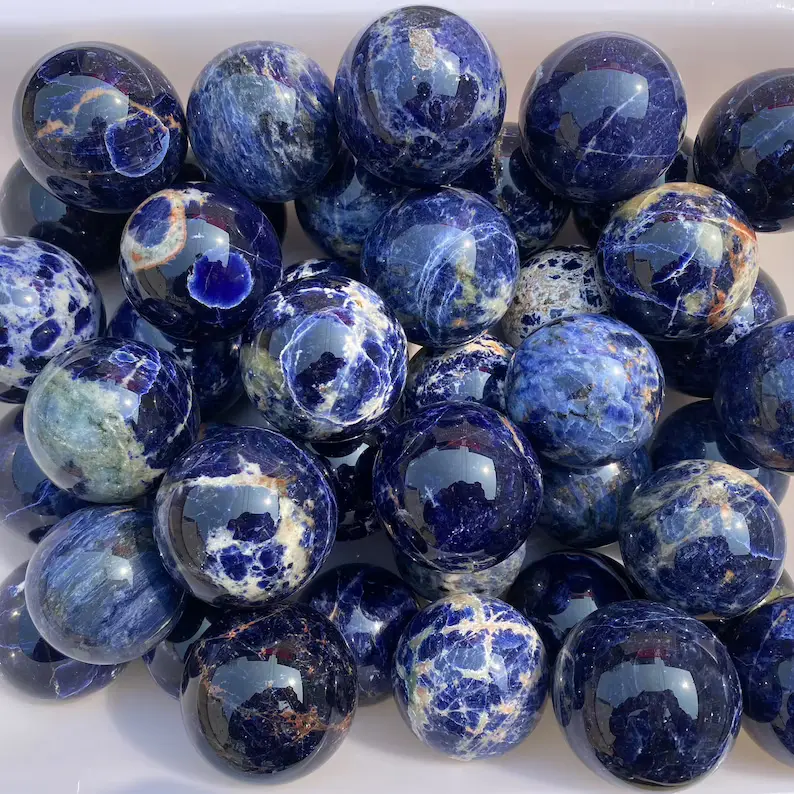
Sodalite has a long and fascinating history that spans many cultures and time periods. It was first discovered in Greenland in 1811 by Danish mineralogist Hans Oersted, and was named “sodalite” in 1814 by French geologist Alexis Damour due to its high sodium content.
In ancient Egypt, sodalite was believed to promote inner peace and harmony. It was often used in amulets and jewelry, and was associated with the goddess Isis. In medieval Europe, sodalite was believed to have healing properties and was often used to treat ailments of the throat and vocal cords.
In the 19th century, sodalite became popular as a decorative stone and was often used in architectural features such as columns and friezes. It was also used in the creation of ornamental objects like vases and bookends.
Today, sodalite is prized for its beauty and is used in a variety of applications. It’s often used as a gemstone for jewelry, as well as for decorative items such as vases, bowls, and sculptures. It’s popularly used in the production of ceramics, glass, and enamel, as well as in the creation of pigments for paints and dyes.
The history of sodalite is a rich and diverse one that speaks to the enduring appeal of this beautiful and versatile mineral. Whether used for its aesthetic beauty or its supposed healing properties, sodalite remains a beloved and intriguing gemstone.
Symbolism of Sodalite
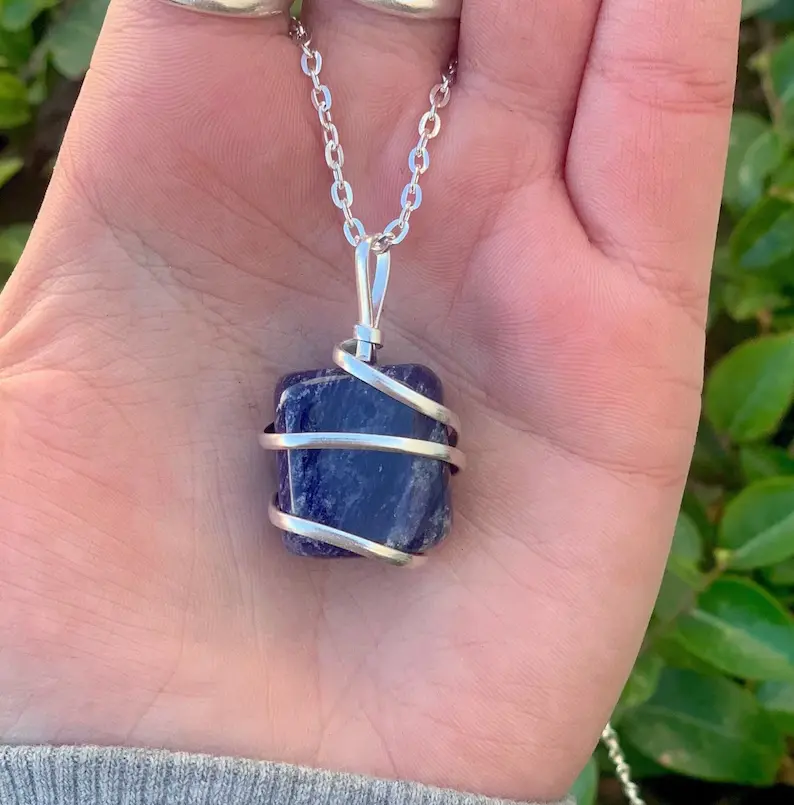
Sodalite is one of those stones inherently connected to heroes and heroines, particularly those who confront tyranny and corruption. This is why it’s also a highly valued gemstone associated with the zodiac sign of Sagittarius. This intrinsically links with achieving goals, setting standards, and revealing untruths with laser-like precision.
However, due to its color, sodalite connects with the water element and with movement. In this way, it also represents communication, particularly poetry, lyricism, and prose. Sodalite is often associated with the throat chakra and is believed to help facilitate clear and effective communication. It’s said to promote confidence, self-expression, and the ability to articulate one’s thoughts and feelings.
Sodalite is also associated with inner peace, harmony, and emotional balance. It’s believed to help calm the mind and promote a sense of inner tranquility, making it a popular stone for meditation and spiritual practice.
This stone is sometimes associated with intuition and psychic abilities. It’s believed to enhance one’s ability to tune into their own inner wisdom and intuition, as well as to connect with higher spiritual realms. Also associated with creativity and artistic expression, sodalite is believed to inspire new ideas, promote innovation, and help overcome creative blocks.
In some traditions, sodalite is believed to provide protection against negative energies and psychic attacks. It’s said to create a shield of energy around the body, preventing harmful energies from entering and disrupting one’s energetic field.
The Healing Properties of Sodalite
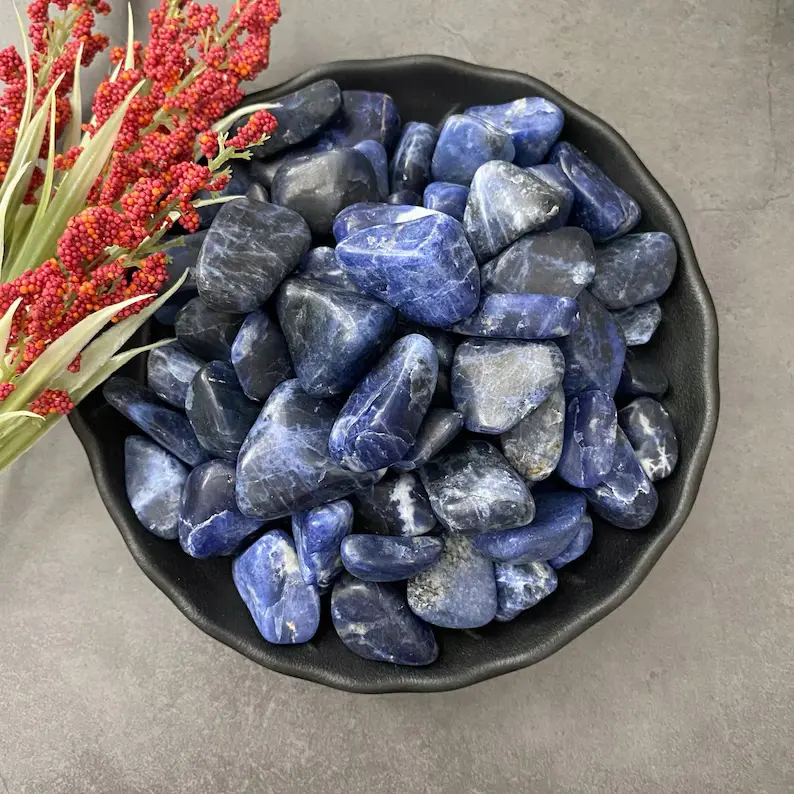
Sodalite is believed to have a variety of healing properties, both physical and emotional. While the healing properties of sodalite are not scientifically proven, many people believe in the potential benefits of working with this stone.
Whether used for physical healing, emotional healing, or spiritual development, sodalite remains a popular and beloved gemstone among crystal enthusiasts and spiritual practitioners. Here’s a look at the various healing properties of this stone:
1. Sodalite Physical Healing Properties
Sodalite can purify the lymph nodes and boost immunity. It’s excellent for throat problems, vocal cord damage, hoarseness, or laryngitis. An elixir can even help reduce fever, lower blood pressure, and help the body stay hydrated. Some say it can also help with insomnia.
Sodalite is said to have a calming and soothing effect on the body, and is believed to help ease anxiety, stress, and tension. It’s also said to have a beneficial effect on the immune system, and may help to boost the body’s natural defenses against illness and disease.
2. Sodalite Emotional Healing Properties
Sodalite is often associated with emotional balance and harmony, and is said to help calm the mind and promote inner peace. It’s believed to help release negative emotions such as fear and guilt, and may help to promote feelings of self-esteem and self-worth.
3. Sodalite in Chakra Work
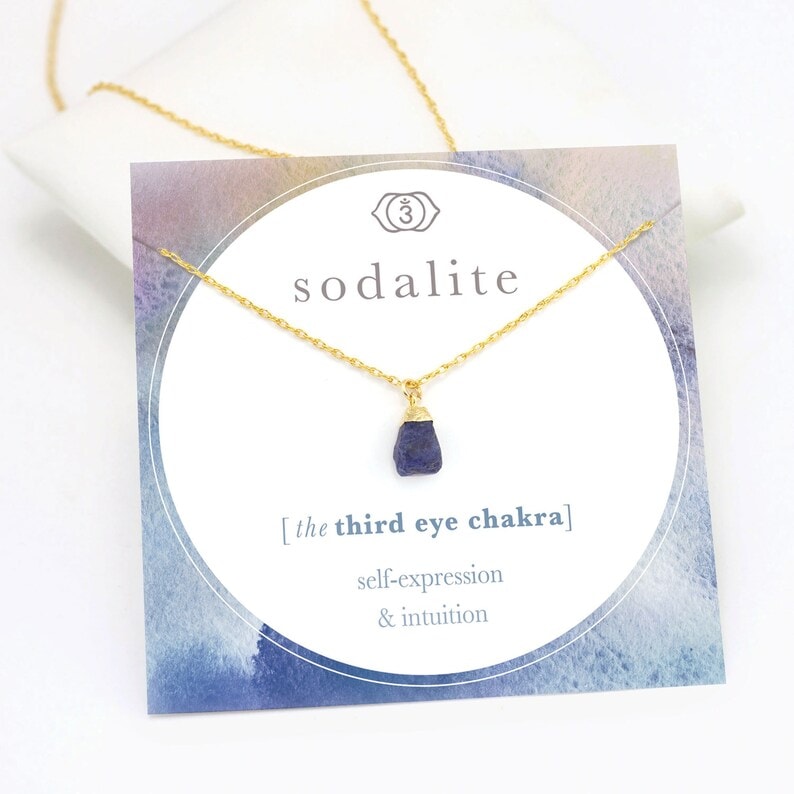
Sodalite is often used in chakra work, particularly for balancing and activating the throat chakra. The throat chakra, also known as the Vishuddha chakra, is located in the neck and is associated with communication, self-expression, and creativity. When the throat chakra is blocked or imbalanced, one may experience difficulty speaking up, expressing their thoughts and feelings, or communicating effectively with others.
Sodalite is believed to help activate and balance the throat chakra, promoting clear and effective communication, as well as self-expression and creativity. It’s said to enhance one’s ability to articulate their thoughts and feelings and may help to overcome communication barriers and misunderstandings.
4. Sodalite Spiritual Healing Properties
Sodalite is believed to have a variety of spiritual healing properties, making it a popular choice among spiritual practitioners and crystal enthusiasts. Here are a few examples:
Inner peace and harmony:
Sodalite is said to promote inner peace, tranquillity, and emotional balance. It’s believed to have a calming effect on the mind and body, helping to alleviate stress, anxiety, and tension. This can make it a useful tool for meditation and spiritual practice.
Intuition and spiritual connection:
Sodalite is sometimes associated with intuition and psychic abilities. It’s believed to enhance one’s ability to tune into their own inner wisdom and intuition, as well as to connect with higher spiritual realms. This can make it a useful tool for those looking to deepen their spiritual practice or explore their own intuitive abilities.
Communication with spirit guides:
Sodalite is said to help facilitate communication with spirit guides, angels, and other spiritual entities. It’s believed to create a bridge between the physical and spiritual realms, helping one to receive guidance and wisdom from higher sources.
Protection:
In some spiritual traditions, sodalite is believed to provide protection against negative energies and psychic attacks. It’s said to create a shield of energy around the body, preventing harmful energies from entering and disrupting one’s energetic field.
Do You Need Sodalite?
Sodalite is excellent for anyone struggling to have their voice heard. It’s ideal for any team or group endeavor, especially when confrontation and/or speaking truth to power is the goal and it’s also good for creative and artistic pursuits.
Additionally, sodalite is ideal for those who want to unravel the mysteries within themselves and the stone, including the power to conquer fear and guilt. Just as the sky appears a crisp cyan after a storm, sodalite also provides that kind of clarity when life becomes too tumultuous for the soul.
How to Use Sodalite
1. Wear Sodalite as Jewelry

Sodalite is a popular choice for jewelry due to its striking blue color and unique patterns. The stone is often cut into cabochons or beads for use in necklaces, bracelets, earrings, and other types of jewelry. Sodalite is known for its calming and soothing energy, which can make it a popular choice for jewelry worn for its spiritual properties.
Sodalite jewelry can come in a variety of designs, from simple and elegant to bold and statement-making. The stone can be paired with other gemstones and metals, or used on its own for a minimalist look. Sodalite can also be used in a variety of jewelry-making techniques, such as wire wrapping, beading, and metalworking.
In addition to its spiritual properties, sodalite jewelry can also be worn for its aesthetic appeal. The stone’s unique patterns and colors make it a popular choice for those looking for a unique and eye-catching piece of jewelry. Sodalite jewelry can be found in a variety of styles and price points, making it accessible to a wide range of consumers.
2. Use Sodalite as a Decorative Item
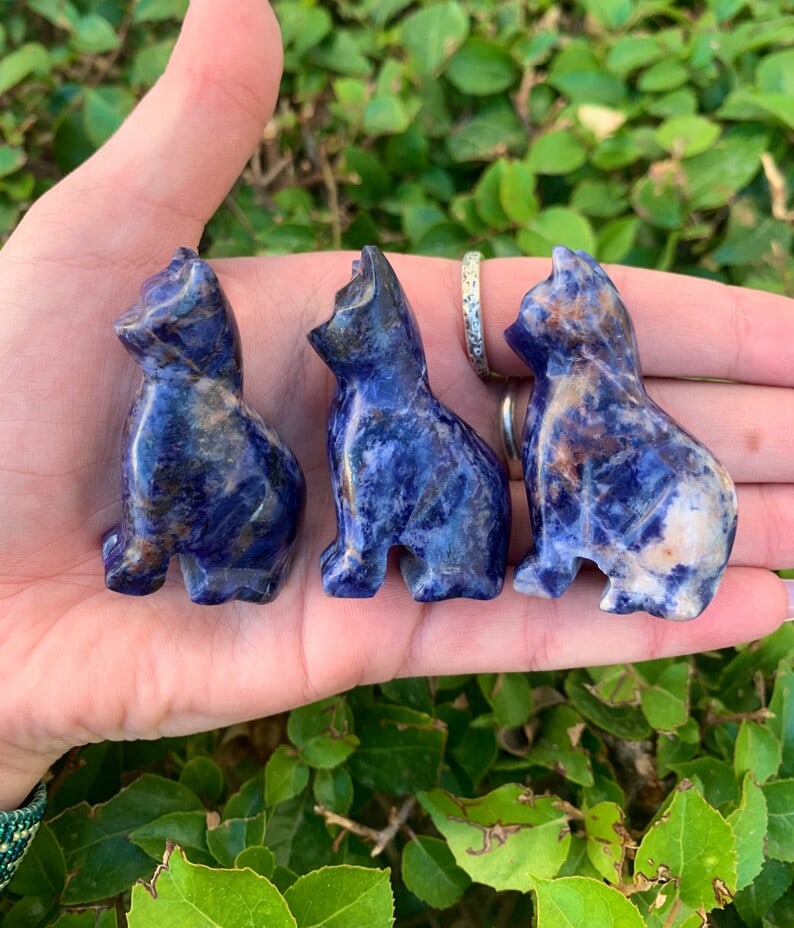
Sodalite can be used in a variety of decorative objects, including bookends, vases, sculptures, and more.
Sodalite bookends are a popular choice for those looking to add a touch of sophistication to their bookshelves. The stone’s weight and durability make it ideal for use as bookends, while its attractive color and pattern can make a stylish statement in any room.
Sodalite vases and bowls can also be used to add a pop of color to any space. The stone’s blue hues can be paired with a variety of other colors and textures, making it a versatile choice for home décor. Sodalite can also be used to create unique and eye-catching sculptures, which can be used as focal points in a room or as part of a larger decorative display.
3. Use Sodalite in Chakra Work and Energy Healing

There are several ways to use sodalite in chakra work and energy healing:
- Placing sodalite on the throat chakra: Lie down and place a sodalite stone on your throat chakra, which is located at the base of your neck. Close your eyes and focus on your breath, allowing the stone to activate and balance the energy of the throat chakra.
- Carrying sodalite in your pocket: Carrying a sodalite stone in your pocket can help to promote a sense of calm and balance throughout the day. Simply hold the stone in your hand or place it on your body when you feel stressed or anxious.
- Meditating with sodalite: Sit comfortably and hold a sodalite stone in your hand. Close your eyes and focus on your breath, allowing the stone to enhance your intuition and insight.
- Placing sodalite on the third eye chakra: Lie down and place a sodalite stone on your third eye chakra, which is located between your eyebrows. Close your eyes and focus on your breath, allowing the stone to stimulate and balance the energy of the third eye chakra.
- Using sodalite in Reiki or crystal healing: A Reiki practitioner or crystal healer can place sodalite stones on or near the body to promote relaxation, balance, and healing.
What Gemstones Pair Well with Sodalite?

Sodalite pairs well with several gemstones, including the following:
- Clear Quartz: Clear Quartz is a powerful amplifier of energy and can enhance the properties of sodalite. Together, they can help to promote clarity, focus, and balance.
- Amethyst: Amethyst is a calming and soothing stone that can enhance the calming properties of sodalite. Combined, these stones can help to promote relaxation and a sense of peace.
- Lapis Lazuli: Lapis Lazuli is another blue stone that can complement the energy of sodalite. Paired together, these two stones can help to enhance intuition, creativity, and self-expression.
- Black Tourmaline: Black Tourmaline is a grounding stone that can help to balance the energy of sodalite. When paired with sodalite, it can help to promote a sense of stability and security.
- Rose Quartz: Rose Quartz is a stone of love and compassion that can complement the calming properties of sodalite. Together, these stones can help to promote self-love and inner peace.
When choosing gemstones to pair with sodalite, it’s important to trust your intuition and choose stones that resonate with you on a personal level. Experiment with different combinations and find the ones that work best for your needs and intentions.
How to Clean and Care for Sodalite
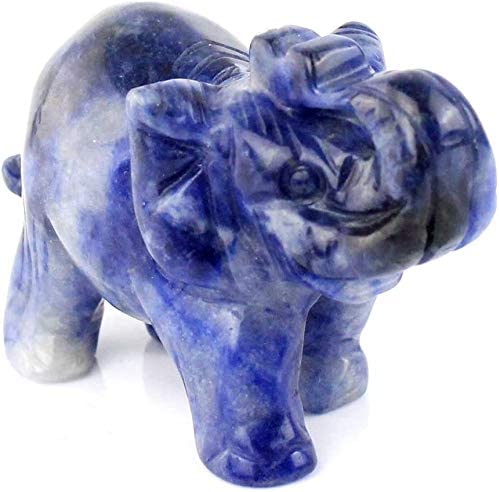
To keep your sodalite looking its best, it’s important to clean, care for, and store it properly. It’s important to follow certain guidelines to make sure that your sodalite is taken good care of.
How to Clean Sodalite:
- Use a soft, lint-free cloth to gently wipe away any dirt or debris on the surface of your sodalite.
- If your sodalite needs a deeper cleaning, you can soak it in warm, soapy water for a few minutes. Be sure to rinse it thoroughly and dry it with a soft cloth.
How to Cleanse Sodalite:
- Sodalite is said to have calming and grounding properties and can help to balance emotions and the mind. To cleanse your sodalite, you can place it in a bowl of saltwater or hold it under running water for a few minutes.
- You can also cleanse your sodalite by placing it on a bed of cleansing crystals such as quartz, amethyst or selenite.
How to Care for Sodalite:
- Sodalite is a relatively soft stone, so it’s important to avoid exposing it to harsh chemicals or high heat.
- Be sure to remove your sodalite jewelry before swimming or showering to prevent damage from exposure to water or chemicals.
- Store your sodalite separately from other jewelry to prevent scratches, and avoid exposing it to sunlight or extreme temperatures.
How to Store Sodalite:
- Store your sodalite in a soft pouch or jewelry box to protect it from scratches and damage.
- Avoid storing your sodalite in direct sunlight or in areas with high humidity or extreme temperatures, as this can damage the stone over time.
By following these tips for cleaning, cleansing, caring for, and storing your sodalite, you can help to ensure that it remains beautiful and vibrant for years to come.
Frequently Asked Questions about Sodalite
Sodalite and lapis lazuli are not the same and have completely different chemical compositions. However, sodalite can be a less expensive alternative to lapis lazuli, although rare and sometimes difficult to come by. Remember, lapis lazuli is a stone whereas sodalite is a pure mineral.
The best way to know if sodalite is real is when pyrite is present. There shouldn’t be any significant amount of pyrite. If there are glittery, gold-like metal flecks throughout the stone, it’s likely lapis lazuli.
Because of sodalite’s blue with white veining, people often mistake it for lazulite, azurite, or dumortierite. All these have a similar appearance but they are different in chemical composition.
To determine if a piece of sodalite is real, put it under ultraviolet light. The fluorescence should look orange in almost all varieties. The only exception is hackmanite, where it will become a deeper and richer blue.
Sodalite is said to symbolize logic, rationality, truth, inner peace, and emotional balance. It is also associated with communication, creativity, and self-expression.
Wrapping Up
Sodalite is a beautiful gemstone with a rich blue color that has captured the hearts of many. Its meaning and healing properties are highly valued, as it’s believed to enhance communication, promote rational thinking, and bring emotional balance. Its calming and soothing energy makes it a popular choice for those seeking to alleviate anxiety and stress.
Sodalite is a highly versatile and powerful stone that can bring a sense of clarity and balance to our lives. So if you’re looking for a stone that can help you access your inner truth and promote inner peace, sodalite is definitely worth considering.





